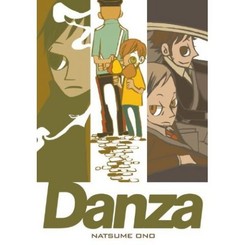Review
by Rebecca Silverman,Danza
GN
| Synopsis: |  |
||
In these six short stories, fathers and sons reunite and come to small understandings, a boy who grows up to be a policeman learns something about revenge, two brothers try to get along, and a rookie New York cop learns some lessons about trusting his partner. |
|||
| Review: | |||
In Italian, Danza means “dance.” While at first this may seem an odd title for a collection of stories that have nothing to do with that activity, after finishing the volume one can see that rather than the physical act of dancing, the title refers to the small emotional tangos, waltzes, and chasses that we perform in order to either get to or avoid a point. Each tale in Natsume Ono's collection focuses on a different relationship and its problems, and while not all of them are resolved, each is somehow changed and the characters move on to another step in the dance. As is typical of Ono's anthologies, the settings in Danza are spread across three continents – two take place in America, three in Italy, and one in Japan. Each has its own quiet power – and all of the stories might be called quiet, as they lack in any physical action, even the ones about police officers – and each tackles a different aspect of a couple's relationship. None of the couples are such in terms of a romantic partnership; the characters are fathers and sons or sons-in-law, partners, superior officer and subordinate, or brothers. Despite these differences, Ono delicately points out the similar pitfalls in all of the relationships, carefully giving us just enough information to see what's going on and how it is resolved. Each story is an exercise in minimalist storytelling, a snapshot of two lives intersecting as we walk past. Perhaps the strongest stories are “Diorama” and “The Gelateria and the Carabinieri.” The latter, one of the stories set in Italy, is also the lightest, about a carabiniero (military policeman) who is stationed outside of one of Rome's most famous gelaterie in the heat of summer. He recalls in passing that as a child, he used to torment the officer who then had the post by eating his gelato right in front of him. He says this in front of a superior officer only to find out that payback really can be a bitch. Told with very few words, this story captures the entire narrative in the least amount of pages given to a tale in the book without some of the awkwardness or drawn-out qualities of others. “Diorama,” the sole story to take place in Japan, deals with a man who is having difficulties accepting the fact that his daughter has married a foreigner. No matter how hard his son-in-law tries, the older man simply cannot get over the fact that this man is The Other. How he comes to terms with his son-in-law is charming, as it shows how the father manages to accept that his daughter might have married someone worthwhile while still allowing him to retain the grumpy bluster that defines the character. The weakest story in the book is “Smoke,” another Italy-based tale that focuses on the relationship between two feuding brothers. Using a tired device – the two are the only two inside when an earthquake forces them into close proximity – Ono attempts to show us both sides of their story and to make us feel at least some sympathy for each of them, but both turn out to be such petty characters mired in their own perceptions that even the story's resolution cannot redeem them. “Rubber Boots,” the opening story, is also a bit weak, though in this case it is because Ono tries to do too much with too little information. Based on the artwork, it looks as though this story was written earlier than the gelateria story, where she has perfected the technique; another early tale, “Memories of the Lake,” on the other hand, suffers from overwriting. As always, Ono's artwork may prove a turnoff for some readers, and it really does vary in quality throughout the volume. Scratchy and awkward, sometimes she is able to evoke great emotion from her characters, while at other times they just look like awkwardly scrawny figures with bulbous eyes and no neck. Sometimes her use of backgrounds is well done – the gelateria is recongizable to those who have been to Rome – while at other times they are a few sketches to remind us that the action is taking place somewhere. To put Danza in context with Ono's other work, some of these stories have artwork comparable to House of Five Leaves while others are far beneath it. If you are already a fan of Natsume Ono's work or are just ready for something a little more removed from spunky teens saving the world, Danza is likely to make you quite happy. A mixed bag of gentle stories, it is more strong than not in its writing, and Kodansha's translation notes help to place each story while the translation itself is smooth and pleasant. Like her previously released short story collection Tesoro, Danza is a book to pick up before bed and read a chapter at a time for six days. Soothing without being dribble, this is for the most part a quiet book for a few peaceful moments in your day. |
| Grade: | |||
|
Overall : B+
Story : B+
Art : C-
+ Several stories are very strong, very pleasant reading. Setting notes are a nice touch. |
|||
| discuss this in the forum (3 posts) | | |||
| Production Info: | ||
|
Full encyclopedia details about Release information about |
||